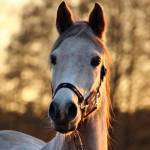New Approach to Headshaking in Horses

The perils of headshaking in horses reach far beyond being an annoyance for riders and visually displeasing to judges and spectators during competition. According to a recently published comprehensive review* on the topic, headshaking can be:
- Potentially harmful to both the horse and rider/handler;
- Characterized by violent, usually vertical, shakes, flicks, or jerks of the head, in the absence of any apparent physical stimulus; and
- Evidenced by snorting, an “anxious” facial expression, and muzzle rubbing that can be so intense that horses strike at their nose with their thoracic limbs, potentially inflicting self-trauma.
“Severely affected horses seem to have compromised welfare and can actually be dangerous to handle or ride due to their unpredictable behavior,” added Laura Petroski-Rose, B.V.M.S., a staff veterinarian for Kentucky Equine Research.
One of the main culprits of headshaking is currently thought to be hypersensitivity of the trigeminal nerve, one of the largest sensory nerves in the horse’s head. Trigeminal-mediated headshaking (TMHS) causes discomfort and affects approximately 5% of the world’s horse population.
Many treatments for headshaking have been suggested over the years, but none has proven curative to date.
“The high failure rate of many TMHS treatments is unsurprising given that they have no effect on correcting the abnormal trigeminal neurophysiology. In addition, because the cause of the underlying trigeminal sensitization is unknown, most treatments used in TMHS are neither specific nor curative,” relayed the reviewer.
The latest attempt at successfully managing, and potentially curing, this condition involves electrical stimulation of the trigeminal nerve.
“The premise behind this approach is to alter the activity of the nerve through electrical stimulation,” explained Petroski-Rose. “Currently, this can be achieved using either percutaneous electrical nerve stimulation (PENS) or electroacupuncture.”
After review data using an equine-specific percutaneous electrical nerve stimulation program in more than 130 horses, the reviewer suggested that owners can expect a 50% rate of success in return to previous level of work. While a 50/50 chance of success may seem unconvincing, frustrated owners of affected horses may jump at this chance to potentially resolve the condition. Treatment failure could be due to lack of technique optimization and headshaking due to reasons other than trigeminal nerve involvement.
“Dental disease and osteoarthritis of the temporomandibular joint or even the temporohyoid joint can also cause discomfort in the head, potentially inducing headshaking” Petroski-Rose advised.
In such cases, consider one of Kentucky Equine Research’s joint supplements, such as KER-Flex (Glucos-A-Flex in Australia), Synovate HA, and EO-3
*Pickles, K. 2019. Is electrical nerve stimulation the answer for management of equine headshaking? Veterinary Clinics of North America Equine Practice 35(2):263-274.








